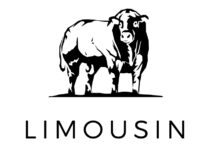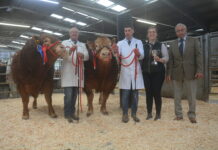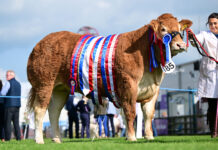ILC Visit – The CHATSWORTH HERD
To be a pedigree Limousin heifer in the Chatsworth herd means spending the summer grazing in stunning parkland which was laid out by Capability Brown in front of the magnificent Chatsworth House in Derbyshire, recently voted England’s finest stately home, and the destination of over 2 million visitors in 2003.
 Chatsworth House was initially constructed in 1552 by Sir William Cavendish and his wife “Bess of Hardwick”. This awe inspiring building, set in the midst of the breathtaking Chatsworth estate has been the home of the Cavendish family ever since.
Chatsworth House was initially constructed in 1552 by Sir William Cavendish and his wife “Bess of Hardwick”. This awe inspiring building, set in the midst of the breathtaking Chatsworth estate has been the home of the Cavendish family ever since.
The 140 plus pedigree breeding females in the Chatsworth Limousin herd are just one of many livestock enterprises overseen by Farm Manager since 1980. His ability to recite the back breeding of any pedigree Chatsworth Limousin, pointed out at random, suggests that of the thousands of stock in his care, the Limmies are his favourites. In addition to the pedigree Limousins, there is a 60 head suckler herd of Limousin crosses, bred in the estate’s dairy herd of 240 pedigree cows, the majority of which are Holstein Friesians. There are also some Dairy Shorthorns and dainty Jerseys – the Chatsworth Jersey herd was founded by the current Duke’s father.
As well as supplying home-bred commercial herd replacements, approximately 20 in-calf Limousin first cross heifers, carrying 3/4 Limousin calves are sold privately each year to local suckler herds.
The 5,300 plus acres of the moorland and grazing at Chatsworth also carries a sheep enterprise totalling almost 4,500 breeding ewes – 3,000 Mules, 500 Mashams, 850 Swaledales and 50 Jacobs.
A range of breeds are employed as service sires – Texels, Rouge de l’Ouest, Suffolk, Charollais, Teeswater and Bluefaced Leicester. Annually on the second Saturday in September, Chatsworth stages a sale of store lambs, breeding/feeding lambs and breeding sheep. At the 37th sale in 2003, a total of 6,236 sheep were catalogued.
Ian Turner introduced the first pedigree Limousins to Chatsworth in 1987 – two cows and two heifers from Peter Pitcher’s Cockleshell herd in Lincolnshire. The following year a further nine females were purchased. The herd was then closed to females. Now in 2004, every single female in the pedigree Chatsworth herd is home-bred. Of the 313 registered Chatsworth Limousins in early April 2004, only five of the six stock bulls did not carry the Chatsworth prefix. The bulls have been sourced from numerous herds – the senior bovine romeo is Hartside Nelson who is usually awarded between 40 and 60 of the pedigree cows. Grange Ovipare and Harrison Sanyo, particularly easy calvers, are used on heifers, including the commercial first cross Limousin heifers, most of which are sired by the home-bred Chatsworth Pisces. All other romancing duties are dealt with by Bolsterstone Superior and Procters Trooper.
 When selecting a new stock bull Ian Turner veers from the traditional path of doing battle in the sale rings of Society sales. He prefers to buy bulls privately from the breeder. “ By going to the farm I’m hopefully able to see the sire and dam, plus possibly some half brothers and sisters, maybe even full siblings. I seek naturally done bulls which haven’t been pushed and look as if they will leave progeny which will do well off forage, and daughters which will make good replacements. If the herd is performance recording I consider the EBVs, particularly the figures for milk, but the bull still needs to look right – I’ve seen some bulls with high EBVs which look like bloomin’ hat racks!”.
When selecting a new stock bull Ian Turner veers from the traditional path of doing battle in the sale rings of Society sales. He prefers to buy bulls privately from the breeder. “ By going to the farm I’m hopefully able to see the sire and dam, plus possibly some half brothers and sisters, maybe even full siblings. I seek naturally done bulls which haven’t been pushed and look as if they will leave progeny which will do well off forage, and daughters which will make good replacements. If the herd is performance recording I consider the EBVs, particularly the figures for milk, but the bull still needs to look right – I’ve seen some bulls with high EBVs which look like bloomin’ hat racks!”.
When the decision was made to introduce the first pedigree beef herd to Chatsworth, Ian Turner had the vast range of native British and Continental breeds to choose from. He decided upon the Limousin for numerous reasons. “Here in Derbyshire we’re in a good cattle area, with plenty of either beef or dairy herds around us. I believed that we would be able to easily sell Limousin bulls locally into both types of herds. Currently we’re selling over a dozen bulls each year to local beef and dairy farmers”. “ Also we needed cows which would survive and thrive on the farm – the land runs up to 900 feet, so although they’re in-wintered, the cows still have to handle some pretty harsh spring and autumn weather”. “ Our pedigree Limousins do not get any special treatment – they run alongside the commercial cows and are treated the same. “We’ve found them to be hardy cows, with good feet and mobility”. “When selecting replacements I have sought to retain heifers from easy calving, milky, meaty cows which are natural thrivers and do a good job of rearing their calves. We weigh all the calves at weaning and place a lot of emphasis on these weights when considering replacements”.
This selection policy has met with independent approval – in 2002 the Chatsworth herd was runner- up in the hotly contested Large Herd section for the North West Midlands and North Wales region. The one thing a beef breed must do is produce BEEF and Chatsworth has an excellent way of ensuring that their cattle are producing the goods. From far and wide, every day, customers flock to the Chatsworth Farm Shop which boasts a taste bud titillating array of tantalising goodies. The main attraction however is the lip smacking display of meat. The beef and lamb is of course home-produced, with calving and lambing organised to ensure a year round supply. Over half of the ? Limousin crosses bred in the commercial herd are sold through the shop, plus some of the pures which do not make the grade for breeding. The remaining commercial cattle are sold as stores in nearby Bakewell market to regular customers from Lincolnshsire and Northamptonshire. Two or three head of finished cattle are slaughtered weekly at a local, family-run abattoir at Glossop, then hung for two weeks before being vacuum packed and matured for a further week.
 “ When selecting cattle for the shop, obviously conformation is important, but so is finish – the 21st Century customer does not want too much fat”, explained Ian. “And because it’s difficult to get a Limousin to go over- fat, the Limousins give us great flexibility when we’re gauging the supply of cattle for the farm shop and our mail order customers”.
“ When selecting cattle for the shop, obviously conformation is important, but so is finish – the 21st Century customer does not want too much fat”, explained Ian. “And because it’s difficult to get a Limousin to go over- fat, the Limousins give us great flexibility when we’re gauging the supply of cattle for the farm shop and our mail order customers”.
The butchery section in the shop has become so popular that in spring 2004 the decision was made to double its size. Head butcher of the large butchery team, who work in full view of the customers, is Paul Neale who came to Chatsworth eight years ago after 28 years in a High Street butcher’s in Chesterfield. “ Before I came to Chatsworth I had hardly worked with Limousin beef”, explained Paul. “My initial and lasting reaction is that it’s the perfect butcher’s meat – the carcase conformation and the amount of muscle in relation to the small amount of bone is excellent. In particular the Limousins are really meaty where it matters – particularly in the eye muscle”. “ Our customers tell us that they shop with us because of the quality and the traceability of the meat, (Ian Turner makes sure there are usually either sheep or cattle grazing adjacent to breeding”, explained Ian Turner. This has helped us to be objective in our replacement selection and we’ve House.
Beyond the gardens lie the Park, laid out by Capability Brown in the 1760’s. Since the pedigree herd was founded, very few females have been sold for breeding – the best have been retained, with the majority of the surplus gracing the dinner plates of the lucky farm shop customers. Over the last seventeen years the Chatsworth pedigree Limousin herd has been moulded into a naturally thriving, meaty and milky herd, calving easily and making a great job of their calves.
Later this year – on October 8th (2004) the Chatsworth herd will hold its very first Production sale – 50 to 60 lots of young animals – first calvers with calves at foot and in calf again, in-calf heifers and maidens. “ We started with a small number of foundation females which has made it easy to identify the way families are reached the stage when we have a lot of youngsters which we would like to keep ourselves. So if they’re good enough for us, hopefully they’ll also appeal to other breeders”. The history of Chatsworth spans hundreds of years, during which time livestock farming has been an integral part of the Estate. Over these Centuries various traditional native British beef breeds have grazed the Chatsworth pastures.
Thanks to the Farm Shop, the complete beef production story, from conception to consumption can be followed at Chatsworth. The dominant theme which runs through this modern beef story is the Limousin breed, which despite less than 40 years of its own British history, blends seamlessly into the centuries old Chatsworth tradition of an on-going quest for the maintenance of the very highest standards. More than 105 acres of marvellous gardens, complete with spell-binding water features, surround Chatsworth Over the centuries Chatsworth’s grandeur and its surroundings have proved irresistible to many of the great landscape artists, who have captured the image in oils and water colours. Some of these paintings show majestic groups of deer grazing in the parkland. For 21st Century artists, the deer are still there, but what Capability Brown nor the early artists could have foreseen – now they share their grazing with pedigree Limousin cattle which proudly carry the Chatsworth name and are very much part of the landscape of this wonderful place.












